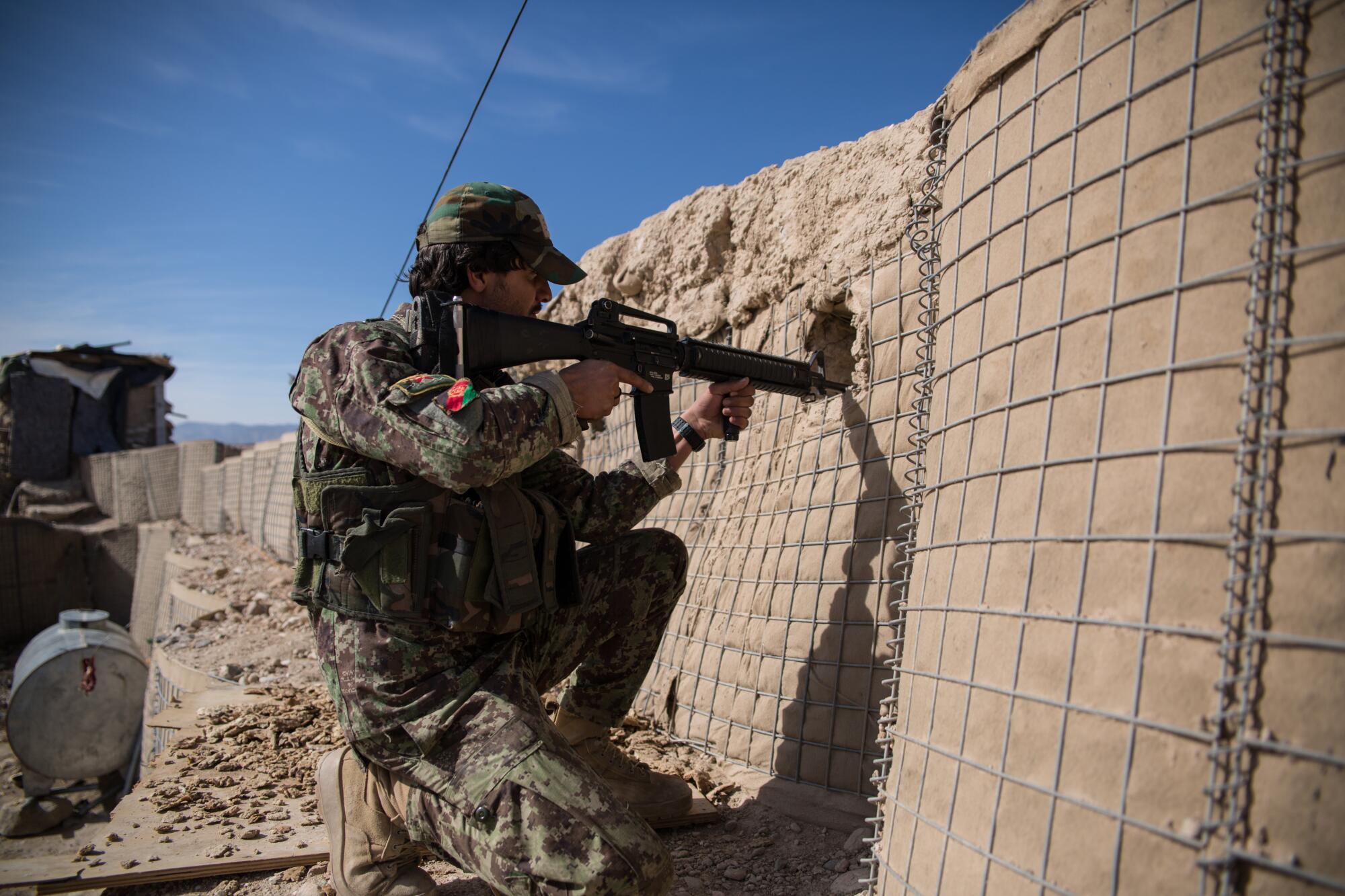
- Share via
QALAT, Afghanistan — The road to Zabol province is specked with craters. Army outposts line a raw landscape of mountains and open steppe. Winds snap hard; signs warn of minefields. The Taliban has blown up most of the bridges.
Children stand by the roadside, making money shoveling dirt into the craters, evening out the road, which is shared by tanks and trucks, soldiers and civilians. Men on crutches with missing legs beg through endless hours. Even if the war ends — it has been going on so long, many have lost hope — their suffering will last a lifetime.
Peace is far from Zabol.
But there is a glimmer. The yearlong negotiations between the U.S. and the Taliban ended last week, and the two sides agreed to a “reduction in violence” followed by a formal peace deal that could come as early as the end of this month. Ahead of the easing of hostilities — the U.S. could not secure a full ceasefire — the reelection of Afghan President Ashraf Ghani was confirmed on Tuesday following a dispute over voting that lasted five months.

The U.S.-Taliban deal is seen as a pathway to peace and will likely reduce the number of U.S. troops in the war-torn country from about 12,000 to 8,600. It would then lead to further withdrawals.
But in the precarious terrain of the southern Afghan province of Zabol, the chance of ending America’s longest war could be spoiled. In these hinterlands, riven by rivalries, suspicions, fresh graves and memories that stretch back to the 1979 Soviet invasion, details sketched out at negotiating tables don’t always come to pass. The people of Zabol are holding their breath — for good reason.
An unofficial ceasefire in three Zabol districts in November was quickly broken. It was aimed at arranging a swap of two Taliban hostages — an American and an Australian university professor — for three high-ranking Taliban commanders held in U.S. custody. But the trust between the sides crumbled and firefights resumed, though the prisoners were eventually exchanged.
“Smaller-scale fighting was still reported during the ceasefire, so personally, I still don’t feel that peace is coming, even now,” said Mohammed Suleman, chief of Afghanistan’s spy agency, the National Directorate of Security in Qalat, Zabol’s provincial capital.
“This past week, violence has intensified in the province, killing 10 soldiers on our side. Of course, the army has also continued their operations. The Taliban is split into different factions, and we don’t trust these groupings. All we’ve seen is war — how can it change from one day to the next?”
The majority of Zabol — home to some 300,000 people — is held by the Taliban. The United Nations announced last year that civilian casualties throughout Afghanistan had reached the highest level since the start of the war in 2001.

Musa Jan’s son was one of them. “He worked as a journalist for a local radio station, was kidnapped, castrated and killed,” said the 45-year-old tribal elder from Qalat as he sat outside his brown mud house with Maleika, his son’s widow.
“I’m left with three children, including a newborn, and the fear that the Taliban might come back,” said the 20-year-old woman. “They murdered my husband. They have no sympathy.”
“What should I think of the Taliban?” asked Jan. “They killed my innocent son. As a civilian, I’m on neither side of the conflict, but I’m scared. One thing is very clear: There is no peace is Zabol. My whole life has been defined by war.”
Fear is deeply entrenched on both sides of the conflict, said Abdul Mutalib, 47, a Taliban commander who agreed to meet with the Los Angeles Times. Mutalib, who at first appeared nervous and uneasy in the interview, said Zabol’s Taliban would adhere to the reduction in violence.
“Of course, this will take time. It will be a step-by-step process,” said Mutalib, a turbaned man with a tan and a shaggy beard. “We want to end the war with the foreigners, but I see problems when it comes to local revenge killings. The shedding of blood continues on this personal level, and there are often rivalries between tribes.”
Allegiance is not always clear-cut, even within the Taliban, with many members having friends and family on the government side, and with tribal loyalties trumping politics. Members of both the Taliban and the Afghan government might switch sides to benefit themselves or their tribes.
“Land disputes are a big reason why people join one or the other side,” Mutalib explained. “Peace deal or not — these issues pertain.” He estimates that the Taliban holds around 60% of Zabol, a number the government disputes. The Ministry of Defense would not disclose the number of soldiers stationed in the province.
In Zabol’s Tarnak Wa Jaldak district, on a hilltop outpost, nine soldiers keep watch over the highway leading south toward neighboring Kandahar, once the Taliban’s heartland. Many soldiers have lived here for months at a time, sleeping on bunk beds in containers and patrolling a barren mountain landscape dotted with snowy peaks rising to the east and a single paved road cutting below.

“We’re all tired — both the Taliban and us. It’s been 40 years. Every Afghan wants peace,” said Amruddin Hakimi, a 22-year-old army commander, who claims that Zabol is one of the country’s most dangerous provinces. He’s come here from Badakhshan, a northern province bordering Tajikistan. Whether the violence reduction will last, he’s unsure.
“Inshallah,” he said, God willing.
“The Taliban is not just one group. There are many sub-groups. Some support Al Qaeda; others fight for Pakistan, so it’s hard to build trust. It will take time,” the commander said, adding that “it might just work for the Taliban to join the government. It’s the best solution we have; there’s little other option.”
He stood on several stacked Hesco blocks — bulletproof mesh containers filled with dirt — overlooking the area. At home in Badakhshan, he has a wife and a son. His wife sends frequent updates and photos to his WhatsApp. They are a welcome distraction. He talks to his wife on the phone every night while he sits outside his container as the stars shine.
“We long for peace, but we don’t yet dare to hope,” he said. “The war’s been with us all of our lives, and we have hoped too often in the past. Our families and children worry, and I’m sure that’s true for Taliban families as well. We all just want to go home.”

Glinski is a special correspondent.
More to Read
Sign up for Essential California
The most important California stories and recommendations in your inbox every morning.
You may occasionally receive promotional content from the Los Angeles Times.











